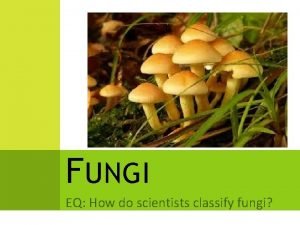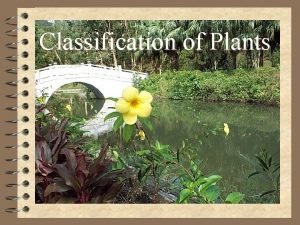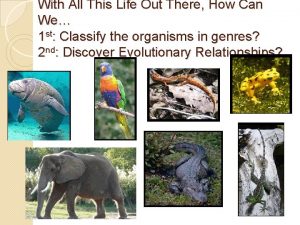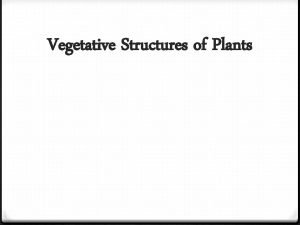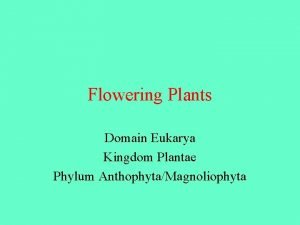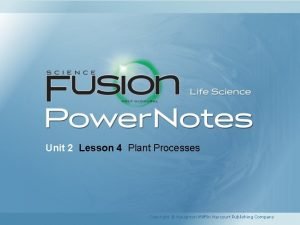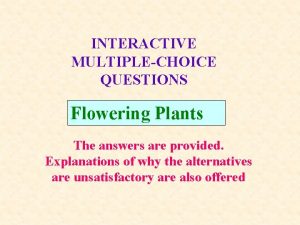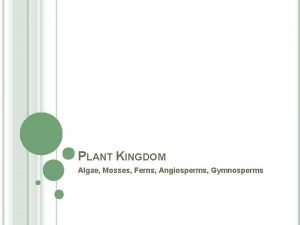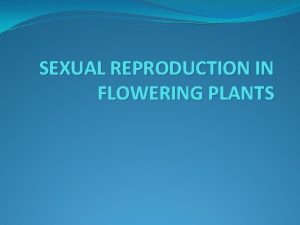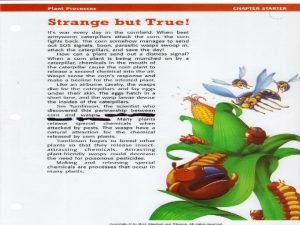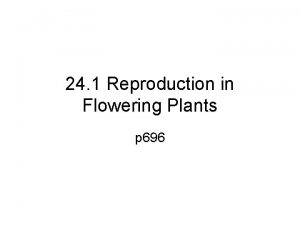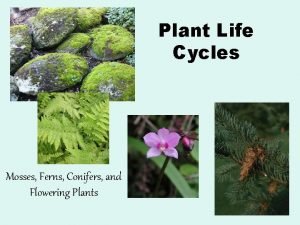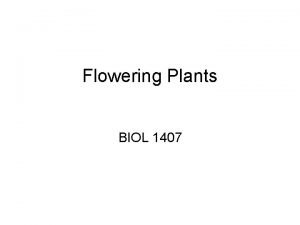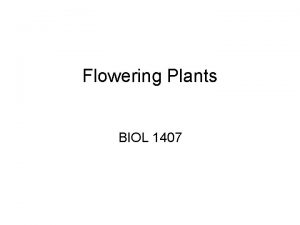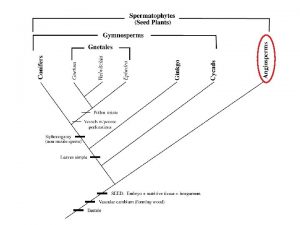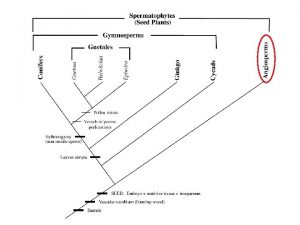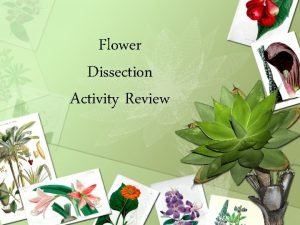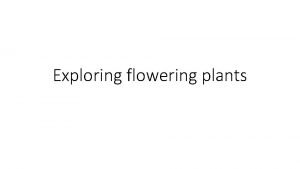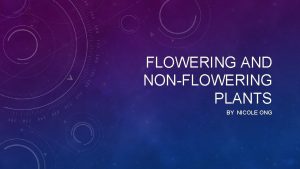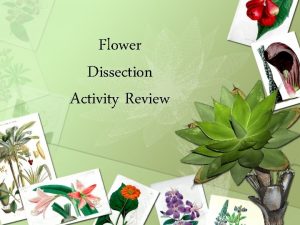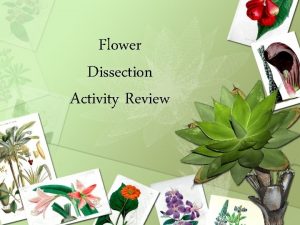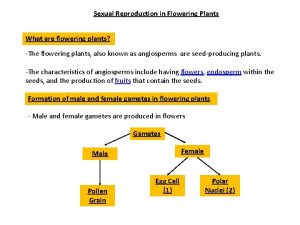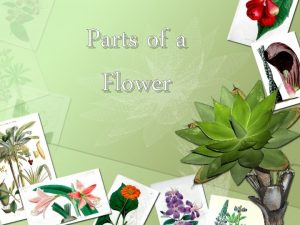Angiospermsthe flowering plants have arrived l l l














- Slides: 14

Angiosperms-the flowering plants have arrived l l l Simone Neethling Biodiversity and Conservation Biology Department University of the Western Cape Available at http: //planet. uwc. ac. za/nisl/Eco_people/Presentations/

Introduction q q q Angiosperms are flowering plants that cover their seeds in a true fruit. Their reproductive organs; an androecium (male) and/or gynoecium (female) lies within the flower structure. Primitive angiosperms are dioecious whereas modern angiosperms are monoecious. Angiosperms are highly successful and dominate the vegetation of the earth’s surface. http: //www. botanical-online. com/floresadaptacionesangles. htm q

Classification taken from Pearson(1995)

Morphology and anatomy q q q The androecium consists of stamens, made up of anthers and filaments. The gynoecium consists of the pistil, made up of the style and stigma. Pollen grains germinate on the stigma, grains have numerous sutures through which a germination tube can emerge thereby ensuring that grains will not land upside down and result in unfavourable germination conditions. The perianth, also forming part of the reproductive system, consists of units that may be differentiated into petals and sepals. There are two other organ systems in angiosperms as well as other plants, namely an anchorage and production system.

Morphology and anatomy http: //www. botanical-online. com/floresadaptacionesangles. htm

Morphology and anatomy q q Angiosperms are also anatomically complex organisms. Dicots have vascular tissues within their stems, roots and leaves that is made up of xylem and phloem bundles in a fixed arrangement this arrangement distinguishes dicots from monocots as monocots’ bundles are scattered. Dicots’ vascular bundles consist of secondary xylem and phloem produced by the cambium within. http: //www. botanical-online. com/floresadaptacionesangles. htm q

Origin q http: //www. botanicalonline. com/floresadaptacionesangleshtm q The Cretaceous era (145 -65 million years ago) saw the rise of flowering plants and their associated insect pollinators through the process of co -evolution. This process between plants and insects was most probably the most influential driving force behind the origin and diversification of angiosperms, although it has been disputed that flexibility in seed production, dispersal and seeding establishment was the most important factors in angiosperm origin.

Origin q q q Two basic hypotheses: Magnolialean and Herbaceous origin hypothesis. The Magnolialean hypothesis suggests that the first angiosperms on earth were woody with large, many parted flowers. These flowering plants were shrubs of semi-xerophytic origin that entered mesic areas as colonizers of unstable habitats – “the weeds of the Early Cretaceous” based on fossil evidence. These Magnolia – like ancestral angiosperms were distinguished from cycad-like gymnosperms, from which they evolved, by having a closed carpel, smaller leaves and sculptured pollen grains and loved in disturbed habitats like stream margins and gravel bars with coarse grained sediments. Herbaceous origin hypothesis implies that the first Angiosperms were small in size and had smaller, few parted flowers. This hypothesis suggests that Angiosperms are derived from a compound gymnosperm; similar to gnetopsids

Impact on other eco-systems q q Angiosperms had major impacts on the evolution of other types of plants and animals. The increase in angiosperms was paralleled by the decline of ferns. Another major driving force behind the rise of angiosperms and angiosperm fruit is the co-evolution feedback between plants and vertebrates that dispersed the fruit. http: //plantphys. info/Plants_Human/pollen. adapt. html q

Angiosperm adaptations to pollination q q q Pollination is a process where pollen is transported from the anther to the stigma. Flowers have adapted in order to attract pollinators. Adaptations include visual cues whereby colour patterns that resemble a “bull’s eye” are utilized. Pollinators therefore see the flower as the target and can be differentiated from the background green foliage. http: //plantphys. info/Plants_Human/pollen. adapt. html

Angiosperm adaptations to pollination q q q Flowering plants have also adapted olfactory cues as some pollinators use their olfactory sense much more than their visual sense; some flowers are also not as visually stimulating as others therefore flowers have also evolved scents. During the process of pollination, pollinators need to benefit from the transportation of pollen therefore rewards for the pollinator has to be present. Flowers therefore produce nectar a valuable food resource. Flowers also produce extra pollen as some pollinators feed on pollen e. g. bees. http: //www. botanical-online. com/floresadaptacionesangles. htm

Angiosperm adaptations to pollination q http: //www. botanicalonline. com/floresadaptacionesangleshtm q The shape of the flower plays a major role for example corollas of some Erica’s are strongly curved to match the beak shape of the main pollinator, the Orangebreasted Sunbird found in South Africa. In fly-pollinated Erica’s, the mouth of corolla is much smaller and lobes are large, star-shaped and spreading thereby providing a landing pad for flies as they insert their long proboscis into the flower to drink nectar.

References q Corbet SA (1978) Bees and the nectar of Echium vulgare. Linnean Society Symposium Series 6: 21 -30 q Mader SS (2004) Biology 8 th Edition. Mc. Graw-Hill, New York, pp 428. ISBN 0 -07 -241882 -6 q Pearson LC (1995) The Diversity and Evolution of Plants. CRC Press, Inc. , United States of America, pp 524 -529. ISBN 0 -84932483 -1 q Taylor DW and Hickey LJ (1996) Flowering Plant Origin, Evolution and Phylogeny. Chapman and Hall, New York, PP 176 -178. ISBN 0412 -05341 -

References q q q Angiosperms http: //en. wikipedia. org/wiki/Angiosperms#History Accessed: 13/03/2006 Angiosperms http: //www. geocites. com/we_evolve/plants/angiosperms. html Accessed: 13/03/2006 Pollination Adaptations http: //plantphys. info/Plants_Human/pollen. adapt. html Accessed: 28/03/2005 Flowers http: //www. botanical-online. com/floresadaptacionesangles. htm Accessed: 28/03/2005 http: //www. unifiedworld. com Accessed: 28/03/2005
 Non flowering plants classification
Non flowering plants classification Basic classification of plants
Basic classification of plants Characteristics of non flowering plants
Characteristics of non flowering plants Phylogenic
Phylogenic Parts of a root system
Parts of a root system Flowering plants phylum
Flowering plants phylum Parts of plants
Parts of plants Unit 2 lesson 12 flowering plants
Unit 2 lesson 12 flowering plants Multiple choice questions on flowering plants
Multiple choice questions on flowering plants Moss fern gymnosperm angiosperm
Moss fern gymnosperm angiosperm Factors affecting flowering in plants ppt
Factors affecting flowering in plants ppt Parts of female plant
Parts of female plant Female part of flower
Female part of flower Is conifer a flowering plant
Is conifer a flowering plant What produces pollen grain
What produces pollen grain

